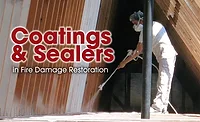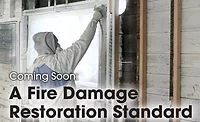Understanding Four Chemistries of Fire Restoration

Photo credit: Christiantdk/iStock / Getty Images Plus via Getty Images
According to the National Fire Protection Association, costs resulting from structure fires have increased by nearly double digits in the past decades. Further, according to the National Academy of Sciences, wildfire frequency and intensity are pushing overall U.S. and Canadian direct fire loss numbers higher. This all points to a need for reliable, comprehensive fire and wildfire restoration standards and practices to restore structures that have not been completely lost.
Fire and smoke remediation represents the oldest of the restoration disciplines, dating back to the great urban fires of the 19th century. It’s also the most complex. Proper restoration techniques must account for the behavior of flames and smoke and how all their forms impact the entirety of the building envelope and contents — not only to restore property value and aesthetics, but also to reduce health impacts for occupants over the long term.
The restoration process predominantly targets combustion particulates such as soot, ash, char and other residuals that remain once the fire itself has been extinguished. But every fire and its restoration dynamics are unique — a basic understanding of fire chemistry is essential to carrying out the process successfully job after job. With this understanding, you’ll be able to make more informed choices about how contaminants are removed, residuals are neutralized, and future odor is sealed. Understanding each fire via the lens of chemistry can altogether improve the restoration process for you and your customers. Let’s explore four fundamental chemistry[i] subsets of fire damage and how each can impact restoration work.
A Fire Itself
Academically, a fire is a chemical reaction. Fuel + oxygen (from the air) + ignition energy = combustion products (mainly CO2 + H2O) + heat energy. The net heat energy at the end exceeds the spark of energy to get the reaction going, and so fire is hot. As long as there is enough fuel and oxygen, the fire will keep burning. However, when this reaction occurs in the real world, site-specific factors contribute to the unique circumstances of every fire.
Unintentional fire, no matter the cause, is inherently an inefficient process. When we burn things for heat and light, we have calibrated the process to be as efficient as possible. For example, an ideal burning candle generates nothing more than CO2 and water. Efficiency is desirable because we want to maximize fuel, but we also want to minimize products of incomplete combustion (PIC) — things like soot, ash and char. Odor virtually always emits from these PICs. A home or building is not optimized for complete combustion, and includes foreign and synthetic elements (paint, carpeting, furniture, etc.) that become PIC producers during an inefficient burn.
The seat of the fire, where the fire originated, is a good example of how chemistry can explain what seems counterintuitive. The seat is usually the area with the greatest thermal burn damage, and it might be thought this is where residues would be most serious and difficult to address. But in reality, this is where the fire was burning most efficiently — and represents the easiest part of initial cleanup. Light cleaning and dry methods may be sufficient.
By contrast, as outward traveling smoke bears soot and ash farther away from the flames, they cool. These residues are less combusted, and often stickier and stubborn, and present a much more challenging cleanup. Further, in the wake of a structure fire the nitrogen from wood, and chlorine from plastics, combine with moisture (extinguishing water) to form corrosive acids that require cleaning and neutralization.
Products of Incomplete Combustion (PICs)
Understanding the chemistry of removing PICs informs productive restoration methods. Selecting the right cleaning formulas depends on chemical interaction with the varied types of combustion particulates.
Wildfire PICs are an example. In these instances, many homes and buildings have not necessarily burned themselves, but are infiltrated by combustion particles. Entering via HVAC systems and structural openings, wildfire fuel mixtures are different: Desiccated vegetation, partially burned soil, conifer pitch, and contaminants from vehicles and structures. Even outdoors, pressure from plumes and convection along the wildfire front is sufficient to drive particles inside via tiny apertures or impaction.
But in the end, aren’t we still cleaning up PICs? Yes — but the chemistry is crucially different because while the wildfire PICs and structure PICs are both corrosive, the choices of which product to clean with while also neutralizing that corrosivity are diametrically opposite. The residues resulting from wildfires tend to be alkalis, meaning they have a pH of greater than seven. When combined with water and humidity from fire suppression efforts, these particulates’ pH levels can rise to above 12, making them very corrosive. An effective cleaner and neutralizer in these instances will be acidic — with a pH level less than seven — which helps to pull the residues’ alkalinity back toward neutral.
But that acid-driven cleaner could be counterproductive at a structure fire. Structure fire residues are typically acidic — treating them with a likewise acidic cleaner could push pH levels below four, which can aggravate corrosion. Here, an alkali cleaner should be selected, again drawing pH levels back toward neutrality.
This structure versus wildfire dichotomy shows how chemistry aids better remediation. Adapt pH to your advantage. Cleaning and simultaneously neutralizing makes for a more efficient remediation project.
Supplementary Disinfection and Deodorization
Sometimes cleaning is all that is needed, but often more is required. After fire PICs have been cleaned and removed, disinfection and deodorization are important to returning to the pre-loss condition. Deodorization starts as smoked material moves from structure to dumpster. This is subtractive deodorization. However, a fire loss may require supplemental disinfection and deodorization.
The use of an antimicrobial can help stop bacteria and mold that proliferate from fire suppression moisture. Further, board-ups, which often result when there is fire damage, can go untouched for weeks or months, and can produce phenomenal microclimates and fungal mayhem. Microbial activity is unhealthy and adds unpleasant decay and putrefaction odors, making elimination essential. Disinfectant labels are regulated by the Environmental Protection Agency (EPA) and Public Health Canada, but disinfectants aren’t often labeled for fire restoration. At minimum, remediators should seek disinfectant products that are EPA registered, have label language for water damage, and a broad range of microbial kill claims. These products can reduce fire-related microbial contamination.
Next, combustion odor poses some crucial challenges tackled by supplemental deodorization. Residues can emit odor indefinitely, making mitigation essential. There are many methods of deodorization, but liquid odor counteractants (OCs) formulated to alter malodor sources represent a good all-purpose solution. Commonly sprayed, fogged or wet-wiped to neutralize airborne and surface odors, the counteractant must make physical contact with the emitting particulates.
These types of products work at the molecular level by altering interaction inside the nose. Certain formulations form polymeric bonds with the odor-causing molecules by electronic, chemical or other activation means, rendering the bonded molecule nonvolatile and odorless; or that is the effective result because of the interpretation by the evolution-honed cooperation between nose and brain. Just as evolution bestowed on humanity a positive reaction to caramelization and the Maillard Reaction, we have a revulsion to the odors of uncontrolled fire. If we can neutralize odor by making perception inoffensive, that tool has restoration value.
Future Odor Suppression
Often considered the final step in deodorization, odor-blocking coatings and sealants are an integral component of fire restoration to prevent the recurrence of smoke odor in the future. Because even the smallest, unaddressed areas can harbor residuals that can release big future odors, sealers provide protection on rough, semi-porous surfaces in both HVAC and structural situations. A sealer makes sense where surfaces are difficult to clean and where future warm conditions can cause surface expansion and an exhaling of retained odor (e.g., attics, HVAC).
Fire damage sealers work by locking down non-removable particulates and inhibiting the future release of fire-related odors. These products will ideally allow water vapor permeability while retaining their odor-containing properties. Water vapor moves through structures, and if a sealer blocks it, condensation and mold growth can occur. Therefore, it’s preferable to apply a smart membrane that can hold back combustion odors while letting the building breathe.
Fire sealers can also serve as primers while blocking stains and adhering to less-than-ideal surfaces, helping prepare the area for repainting. Newer, water-based technology has proven to be every bit as effective at odor blocking but more vapor permeable and environmentally compliant than solvent-borne predecessors. The restorer has more chemistry than ever at their fingertips to achieve a healthy built environment.
[i] It isn’t all chemistry – there is some physics and biology too. All of it is layman level intentionally.
Looking for a reprint of this article?
From high-res PDFs to custom plaques, order your copy today!







